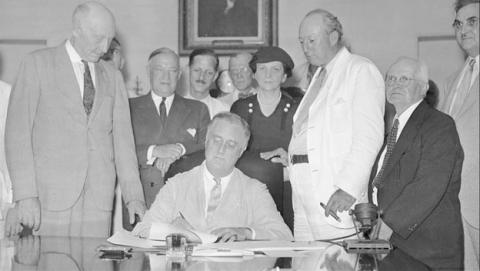Mattress Makings
As a part of the “New Deal” programs of the mid to late 1930s, mattress-making workshops were organized and conducted at local churches and elementary schools across Union County. Each family could make enough mattresses for all the beds in their household. This was a federal government program through the Works Progress Administration (WPA). The particular mattress-making I attended with my sister, Johnnie Heiskell Merritt, and our mother, Elsie Seymour Heiskell, was at Raccoon Valley School. This school had been built by the Works Progress Administration and opened about 1938.
I remember the children playing on the school grounds while our mothers worked on the mattresses. The instructor was Mrs. Emma Gentry. We walked to Raccoon Valley with Mrs. Della Lynch, who also made mattresses. I believe their youngest daughter, Mona Lynch George, went along with us as well.
Up until this time, our beds had straw “ticks,” and feather “ticks,” We also had feather pillows made by our mother, who had raised and picked the geese.
My family grew wheat. A neighbor had a threshing machine and harvested the wheat. The wheat was stored in grass sacks until needed for bread flour. My brothers took a sack of wheat and a sack of corn by horseback to Ailor Mill for grinding. What we called our meal chest was, I believe, really a blanket chest converted to hold meal and flour by adding a divider in the middle. One side held meal and the sifter. The other side held flour and another sifter.
The fresh straw from the wheat threshing was placed by hand into heavy muslin cases or “ticks” and placed on the bed frames. The old straw was carried away and sometimes used to line the stables in the barn.
When researching to refresh my childhood memories, it was easy to find the “big picture,” but so far I have not found anything about the specific projects completed in Union County except through oral history.
Some years ago I had the privilege of talking with the late Malcolm Walker again, and he remembered the mattress making at Taylor’s Grove Church in the Lead Mine Bend Community.
Malcolm said he believed his mother made three or four mattresses, which he loaded on top of his 1930 Model A, tied them down with rope and hauled them home. He had to make two trips. He also hauled the mattresses for his uncle and aunt, Henry and Rada Walker, who lived near the present site of Ronnie Stiner’s barn. Ulysses Hopper hauled his family’s mattresses home by sled. I do not remember who hauled our mattresses, but our brother Roscoe Heiskell had a truck at that time, so he probably hauled mattresses for several families. Malcolm remembered that a long pole or stick was used to beat the cotton flat once it had been placed in the cover. As I recall, the mattresses were tacked about every 12 inches to hold the cotton in place. Families had to pay for the material used to make the mattresses. The covers were made of navy blue and white stripped denim-type material.
Malcolm did not recall who the instructor may have been at Taylor’s Grove, but I found that the average salary of WPA workers was $41.57 a month. Nonetheless, mattress making was probably considered a lower level skill, and the pay for the instructor may have been less.
As an aside, Malcolm also told me he bought his 1930 Model A in Detroit during a visit to his brother who lived in Monroe, Michigan. He says the car was used but in excellent shape, and he paid $62 for it. It was a shiny royal blue with a stripe down the side. He doesn’t remember the exact year, but his neighbors, Bud and Etter Hopper, were visiting near his brother at the same time and asked to ride home with him. They left Monroe at 9 pm one evening and arrived home about that same time the next day. All three took turns driving the then two-lane road from Michigan to Tennessee.
I am most interested in saving this part of Union County history and would encourage anyone to share with me their stories about the New Deal programs and how these programs affected their lives.
- Log in to post comments
